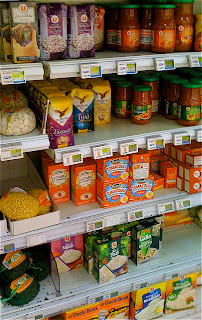Scanning the ingredients, I was pretty sure I could find everything at our local branch of the U-Marché on the rue Montorgeuil.
What held me back, though, was the fact that our elevator has been broken for almost three weeks now, so, due to the back problem, I've not been all that eager to go down, and then back up, six flights of stairs.
However, with Matthew at my side (to carry the shopping bag!), and with recipe in hand, I decided to give it a go.
At the U-Marché we had no trouble finding the neck of lamb, the carrots, turnips, celery, leeks and onions. My pencil checked off each ingredient as we went along, until all that remained was the pearl barley (orge pérlée).
We stopped in front of the "grains" shelf and looked around. Hmm. Thai rice, Basmati rice, Jasmine rice, Arborio rice, wild rice, three-grained rice, long grained rice, short-grained rice, even dear old Uncle Ben's rice! We found cous-cous in various flavors, several choices of lentils, and a big sack of kernels of corn. But no pearl barley.
Clearly we had a problem, because this was the key ingredient. What to do. Well, here in France, when you can't find something, then you find someone to help you find it. And this is where you run into a most endearing trait of life in this country.
Matthew went off in search of assistance, returning a few minutes later with two members of the staff, both women. We explained what we were looking for. They looked puzzled. "What are you cooking, Madame?" "Un ragout d'agneau," I replied, showing them the recipe. There then followed a lengthy conversation about how delicious lamb stew is! I translated the ingredients, going down the list. They nodded at each one, until we got to pearl barley. "Orge pérlée," we repeated. Ah, now they understood. They scoured the shelves again, finding only another row of rice at the very bottom.
Well, perhaps I could substitute rice for the barley I suggested. They shook their heads emphatically. No no, Madame, that wouldn't work because this one was the wrong shape, that one was too soft, those others wouldn't have the right texture, etc.
They must have spent close to fifteen minutes discussing the problem with us, as if they had all the time in the world, and our search for pearl barley was the most important thing they could be doing at that particular moment. This is not unusual here. No matter what kind of store you're in, you almost always have to wait to get help. Sometimes the lines in the post office can be incredibly long, for instance. But once it's "your turn", then you hold center stage for as long as you need to solve your problem. For visitors, and especially Americans, it definitely requires an adjustment to be patient when you're waiting, but none of the locals complain because at the end of the day, you will have your turn!!
We thanked the two women for their time and efforts, wished them "bonne journée" and turned to go to the checkout. Before we left the market, one of them suggested we try the Moroccan Spice Store further down the street.
Matthew headed down to the bottom of rue Montorgeuil, where this delightful Marrakesh emporium offers nuts and fruits and fresh spices. And there...right inside the entrance...front and center...
...stood a large bin of "d'orge pérlée!" Eureka! Matthew explained to the proprietor that we'd been up at the U-Marché, and had just about given up when they had suggested we try his store. "Ah, yes, we all know each other here on rue Montorgeuil," he said measuring out half a kilo. "If it's not enough," he went on, "come on back, we're open until 11 pm."
Luckily, it was more than enough. I went to work in the kitchen, and before long, delicious aromas permeated throughout the flat. At dinner that evening we sat down to sample this new dish. What can I say, it was utterly delicious. Perhaps made even more so, by the sweet memories of the friendly, helpful merchants on the rue Montorgeuil.
BON APPETIT!
À bientôt!











































